HRM Report: Function and Purpose of HRM for Tesco Analysis
VerifiedAdded on 2020/07/23
|21
|6781
|48
Report
AI Summary
This report provides a comprehensive analysis of Human Resource Management (HRM), focusing on its functions, purpose, and application within an organization, particularly in the context of Tesco. The report explores the core activities of HRM, including recruitment, selection, training and development, performance management, and employee relations. It delves into workforce planning, different approaches to recruitment and selection, and the impact of technology on HRM practices. The report also examines the importance of employee relations, employment legislation, and the application of HRM in the workplace. Furthermore, it covers the strengths and weaknesses of various HRM approaches, analyzing employee turnover and the factors influencing it. The PESTEL analysis is used to examine the external factors that influence HRM.
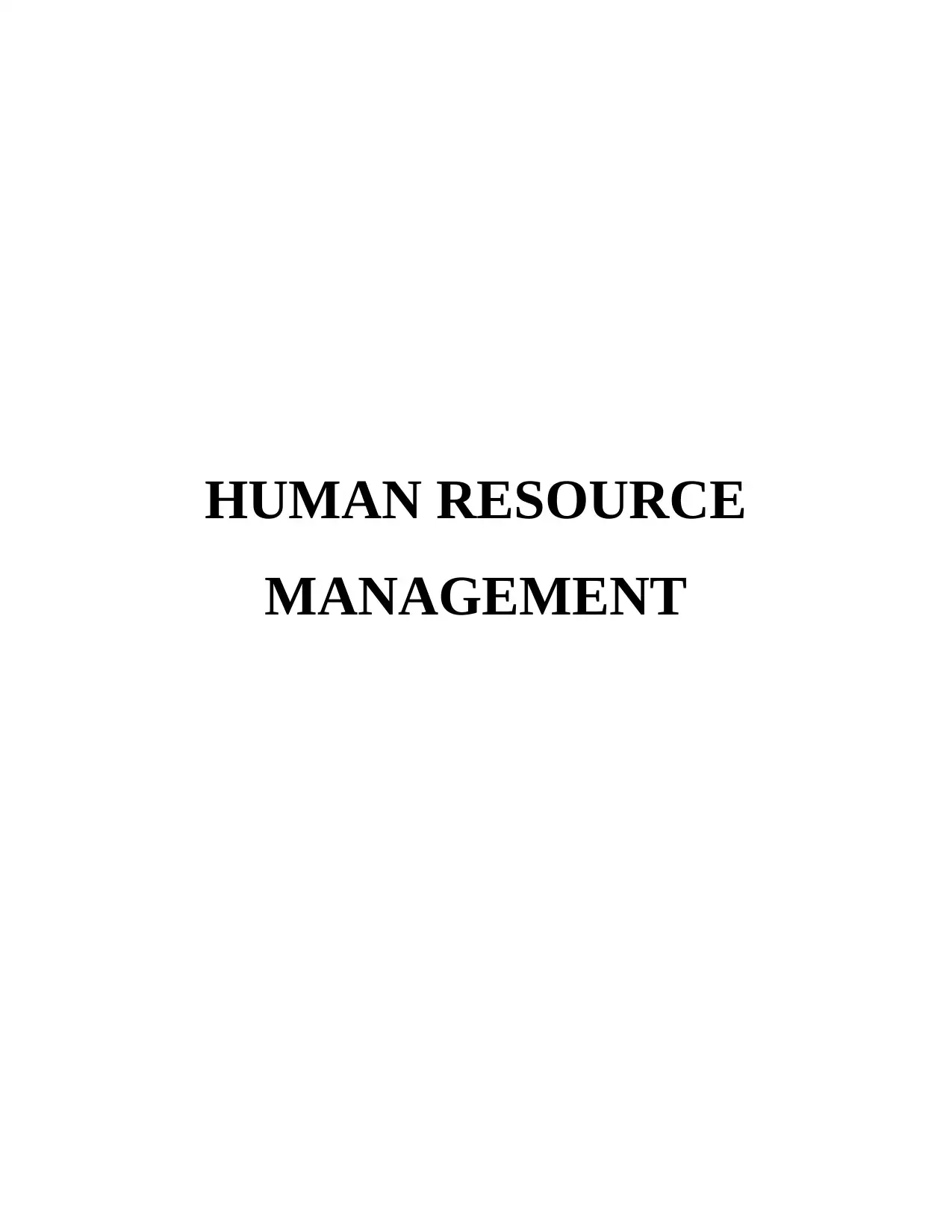
HUMAN RESOURCE
MANAGEMENT
MANAGEMENT
Paraphrase This Document
Need a fresh take? Get an instant paraphrase of this document with our AI Paraphraser
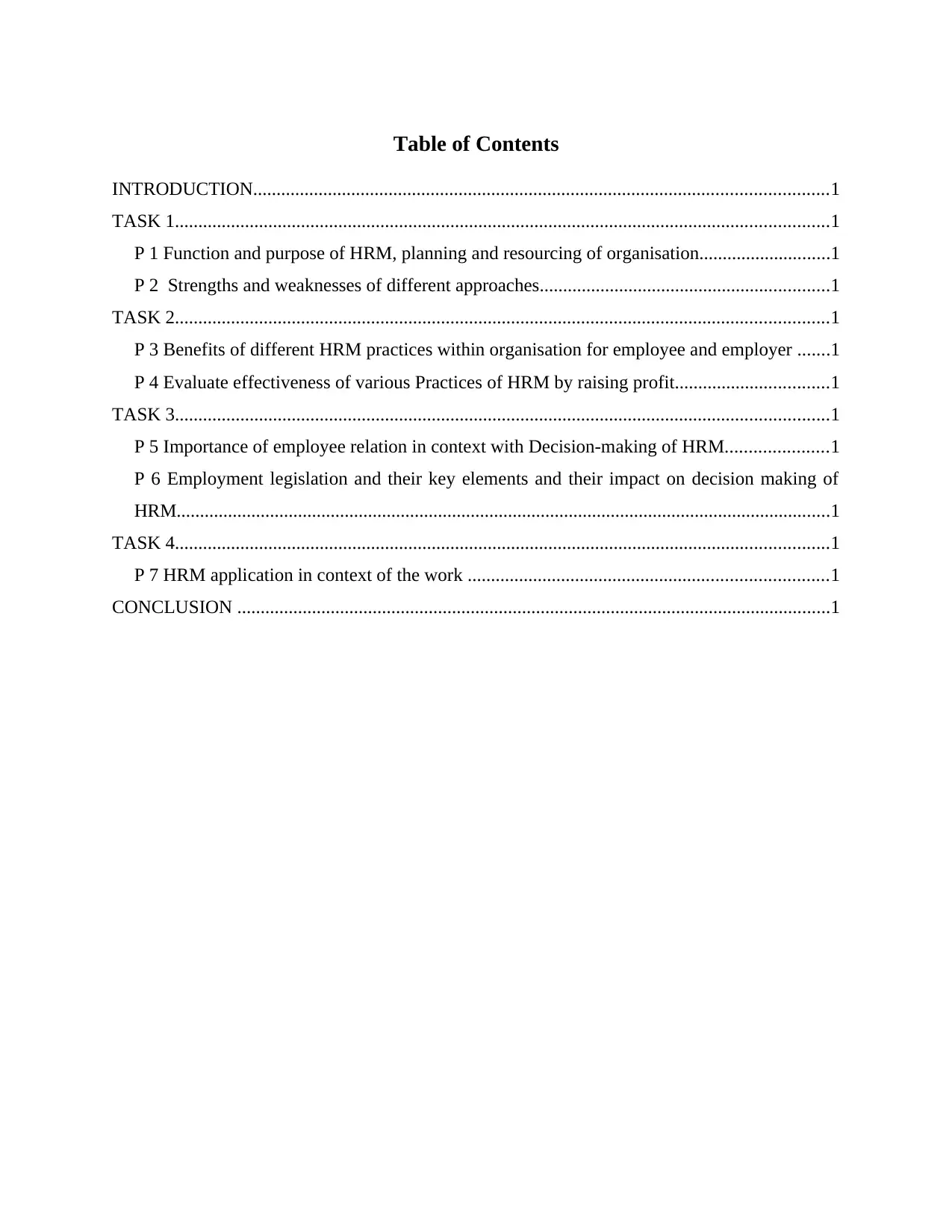
Table of Contents
INTRODUCTION...........................................................................................................................1
TASK 1............................................................................................................................................1
P 1 Function and purpose of HRM, planning and resourcing of organisation............................1
P 2 Strengths and weaknesses of different approaches..............................................................1
TASK 2............................................................................................................................................1
P 3 Benefits of different HRM practices within organisation for employee and employer .......1
P 4 Evaluate effectiveness of various Practices of HRM by raising profit.................................1
TASK 3............................................................................................................................................1
P 5 Importance of employee relation in context with Decision-making of HRM......................1
P 6 Employment legislation and their key elements and their impact on decision making of
HRM............................................................................................................................................1
TASK 4............................................................................................................................................1
P 7 HRM application in context of the work .............................................................................1
CONCLUSION ...............................................................................................................................1
INTRODUCTION...........................................................................................................................1
TASK 1............................................................................................................................................1
P 1 Function and purpose of HRM, planning and resourcing of organisation............................1
P 2 Strengths and weaknesses of different approaches..............................................................1
TASK 2............................................................................................................................................1
P 3 Benefits of different HRM practices within organisation for employee and employer .......1
P 4 Evaluate effectiveness of various Practices of HRM by raising profit.................................1
TASK 3............................................................................................................................................1
P 5 Importance of employee relation in context with Decision-making of HRM......................1
P 6 Employment legislation and their key elements and their impact on decision making of
HRM............................................................................................................................................1
TASK 4............................................................................................................................................1
P 7 HRM application in context of the work .............................................................................1
CONCLUSION ...............................................................................................................................1

⊘ This is a preview!⊘
Do you want full access?
Subscribe today to unlock all pages.

Trusted by 1+ million students worldwide
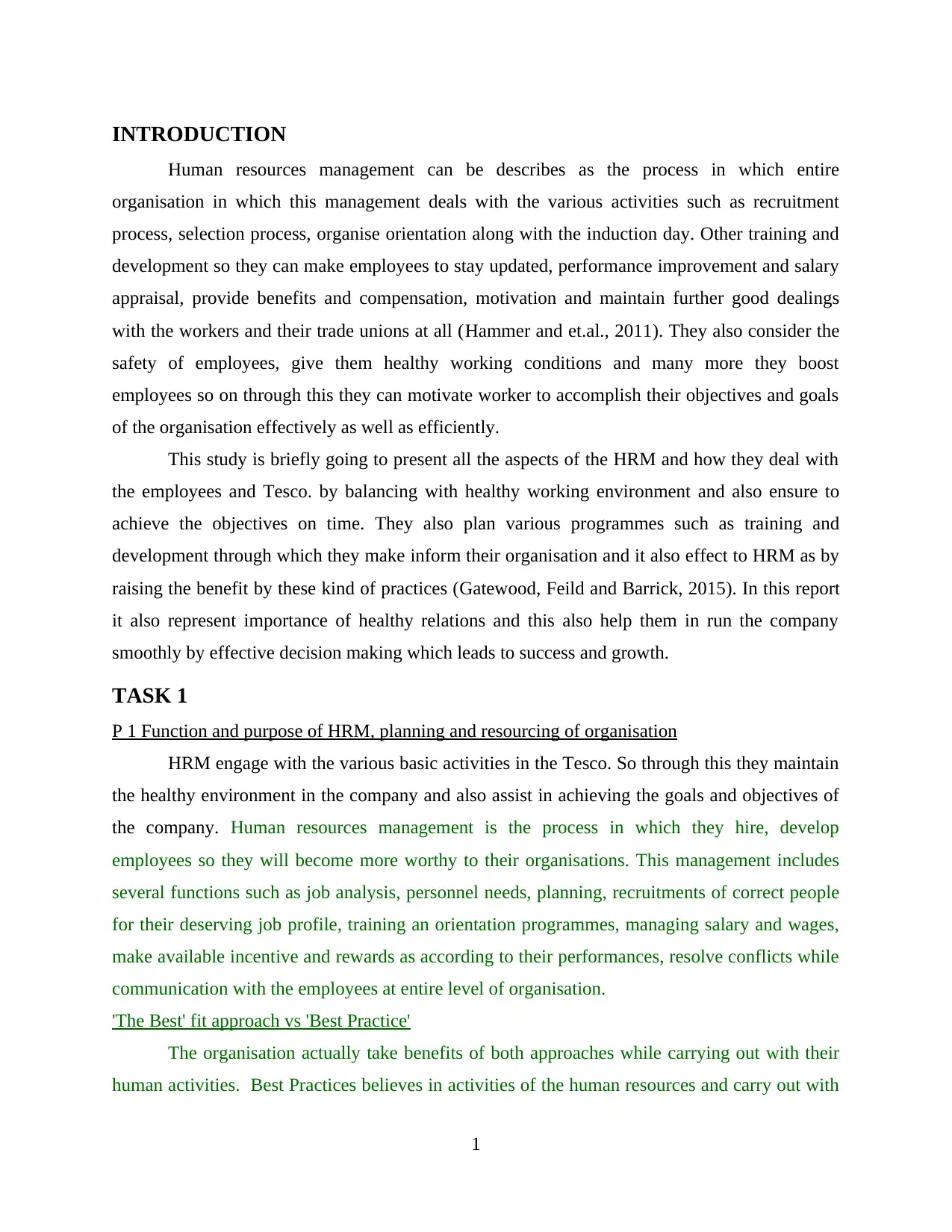
INTRODUCTION
Human resources management can be describes as the process in which entire
organisation in which this management deals with the various activities such as recruitment
process, selection process, organise orientation along with the induction day. Other training and
development so they can make employees to stay updated, performance improvement and salary
appraisal, provide benefits and compensation, motivation and maintain further good dealings
with the workers and their trade unions at all (Hammer and et.al., 2011). They also consider the
safety of employees, give them healthy working conditions and many more they boost
employees so on through this they can motivate worker to accomplish their objectives and goals
of the organisation effectively as well as efficiently.
This study is briefly going to present all the aspects of the HRM and how they deal with
the employees and Tesco. by balancing with healthy working environment and also ensure to
achieve the objectives on time. They also plan various programmes such as training and
development through which they make inform their organisation and it also effect to HRM as by
raising the benefit by these kind of practices (Gatewood, Feild and Barrick, 2015). In this report
it also represent importance of healthy relations and this also help them in run the company
smoothly by effective decision making which leads to success and growth.
TASK 1
P 1 Function and purpose of HRM, planning and resourcing of organisation
HRM engage with the various basic activities in the Tesco. So through this they maintain
the healthy environment in the company and also assist in achieving the goals and objectives of
the company. Human resources management is the process in which they hire, develop
employees so they will become more worthy to their organisations. This management includes
several functions such as job analysis, personnel needs, planning, recruitments of correct people
for their deserving job profile, training an orientation programmes, managing salary and wages,
make available incentive and rewards as according to their performances, resolve conflicts while
communication with the employees at entire level of organisation.
'The Best' fit approach vs 'Best Practice'
The organisation actually take benefits of both approaches while carrying out with their
human activities. Best Practices believes in activities of the human resources and carry out with
1
Human resources management can be describes as the process in which entire
organisation in which this management deals with the various activities such as recruitment
process, selection process, organise orientation along with the induction day. Other training and
development so they can make employees to stay updated, performance improvement and salary
appraisal, provide benefits and compensation, motivation and maintain further good dealings
with the workers and their trade unions at all (Hammer and et.al., 2011). They also consider the
safety of employees, give them healthy working conditions and many more they boost
employees so on through this they can motivate worker to accomplish their objectives and goals
of the organisation effectively as well as efficiently.
This study is briefly going to present all the aspects of the HRM and how they deal with
the employees and Tesco. by balancing with healthy working environment and also ensure to
achieve the objectives on time. They also plan various programmes such as training and
development through which they make inform their organisation and it also effect to HRM as by
raising the benefit by these kind of practices (Gatewood, Feild and Barrick, 2015). In this report
it also represent importance of healthy relations and this also help them in run the company
smoothly by effective decision making which leads to success and growth.
TASK 1
P 1 Function and purpose of HRM, planning and resourcing of organisation
HRM engage with the various basic activities in the Tesco. So through this they maintain
the healthy environment in the company and also assist in achieving the goals and objectives of
the company. Human resources management is the process in which they hire, develop
employees so they will become more worthy to their organisations. This management includes
several functions such as job analysis, personnel needs, planning, recruitments of correct people
for their deserving job profile, training an orientation programmes, managing salary and wages,
make available incentive and rewards as according to their performances, resolve conflicts while
communication with the employees at entire level of organisation.
'The Best' fit approach vs 'Best Practice'
The organisation actually take benefits of both approaches while carrying out with their
human activities. Best Practices believes in activities of the human resources and carry out with
1
Paraphrase This Document
Need a fresh take? Get an instant paraphrase of this document with our AI Paraphraser

following set of the practising HRM which is enough able to improve performance of the
organisation with the respect of locations and other sizes of organisations. On the other hand,
Best fit refers to the policies of HR which align to business strategies while performing high
practice which achieved. Practices advocates postulated employee security employee selection
along with effective teams while compensating strategies and many more.
Soft and Hard Models of HRM
Basic Hard HRM Soft HRM
Time scale It is seen as short term policies
such as hire and fire of employee
It take as a long term view by using
workforce effectively as possible to long
term corporate objectives.
Key features Employees paid little as
possible
Employees has limited
control of their working
life
Downward
communication
Managers consult regularly with
employees.
Managers control their working
life as delegations, delaying etc.
Emphasis on training and
development .
Motivational
techniques used
Motivated by pay, limited use of
delegation system and team
work.
Delegation empowerment, use of
extensive techniques designed to give
power to employees.
Workforce planning :- It is continuous process which is used to align priorities and needs of the
business with workforce to make sure in order to meet regulatory, legislative, production
requirement and services. It is the proof of development of workforce strategies there are
classified into three categories are as follow :- Long term plan :- It consider financial and investment planning, budgeting. Medium term plan :- It needed work load and headcount planning.
Short term plan :- Its an weekly or day to day control over the scheduling, material and
loading.
2
organisation with the respect of locations and other sizes of organisations. On the other hand,
Best fit refers to the policies of HR which align to business strategies while performing high
practice which achieved. Practices advocates postulated employee security employee selection
along with effective teams while compensating strategies and many more.
Soft and Hard Models of HRM
Basic Hard HRM Soft HRM
Time scale It is seen as short term policies
such as hire and fire of employee
It take as a long term view by using
workforce effectively as possible to long
term corporate objectives.
Key features Employees paid little as
possible
Employees has limited
control of their working
life
Downward
communication
Managers consult regularly with
employees.
Managers control their working
life as delegations, delaying etc.
Emphasis on training and
development .
Motivational
techniques used
Motivated by pay, limited use of
delegation system and team
work.
Delegation empowerment, use of
extensive techniques designed to give
power to employees.
Workforce planning :- It is continuous process which is used to align priorities and needs of the
business with workforce to make sure in order to meet regulatory, legislative, production
requirement and services. It is the proof of development of workforce strategies there are
classified into three categories are as follow :- Long term plan :- It consider financial and investment planning, budgeting. Medium term plan :- It needed work load and headcount planning.
Short term plan :- Its an weekly or day to day control over the scheduling, material and
loading.
2
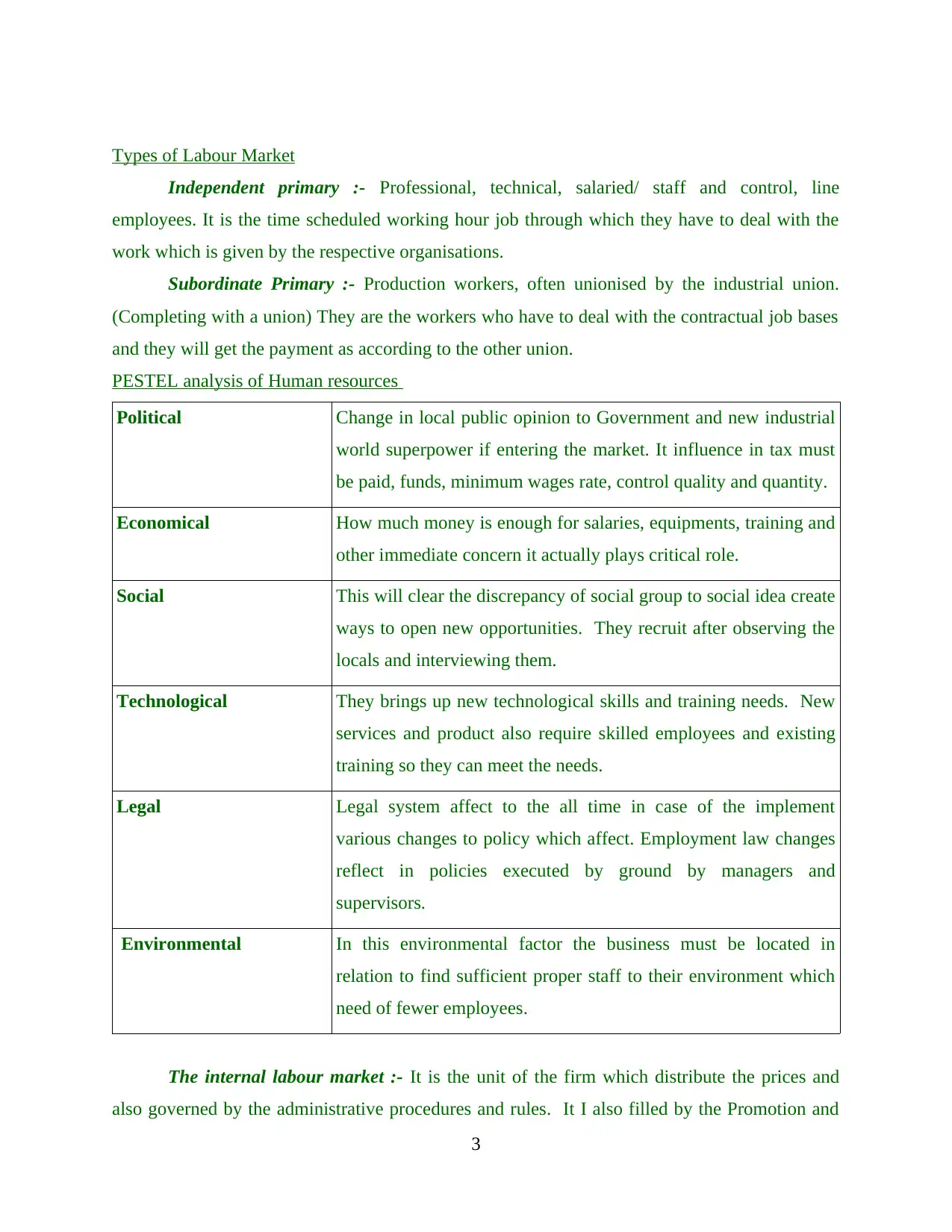
Types of Labour Market
Independent primary :- Professional, technical, salaried/ staff and control, line
employees. It is the time scheduled working hour job through which they have to deal with the
work which is given by the respective organisations.
Subordinate Primary :- Production workers, often unionised by the industrial union.
(Completing with a union) They are the workers who have to deal with the contractual job bases
and they will get the payment as according to the other union.
PESTEL analysis of Human resources
Political Change in local public opinion to Government and new industrial
world superpower if entering the market. It influence in tax must
be paid, funds, minimum wages rate, control quality and quantity.
Economical How much money is enough for salaries, equipments, training and
other immediate concern it actually plays critical role.
Social This will clear the discrepancy of social group to social idea create
ways to open new opportunities. They recruit after observing the
locals and interviewing them.
Technological They brings up new technological skills and training needs. New
services and product also require skilled employees and existing
training so they can meet the needs.
Legal Legal system affect to the all time in case of the implement
various changes to policy which affect. Employment law changes
reflect in policies executed by ground by managers and
supervisors.
Environmental In this environmental factor the business must be located in
relation to find sufficient proper staff to their environment which
need of fewer employees.
The internal labour market :- It is the unit of the firm which distribute the prices and
also governed by the administrative procedures and rules. It I also filled by the Promotion and
3
Independent primary :- Professional, technical, salaried/ staff and control, line
employees. It is the time scheduled working hour job through which they have to deal with the
work which is given by the respective organisations.
Subordinate Primary :- Production workers, often unionised by the industrial union.
(Completing with a union) They are the workers who have to deal with the contractual job bases
and they will get the payment as according to the other union.
PESTEL analysis of Human resources
Political Change in local public opinion to Government and new industrial
world superpower if entering the market. It influence in tax must
be paid, funds, minimum wages rate, control quality and quantity.
Economical How much money is enough for salaries, equipments, training and
other immediate concern it actually plays critical role.
Social This will clear the discrepancy of social group to social idea create
ways to open new opportunities. They recruit after observing the
locals and interviewing them.
Technological They brings up new technological skills and training needs. New
services and product also require skilled employees and existing
training so they can meet the needs.
Legal Legal system affect to the all time in case of the implement
various changes to policy which affect. Employment law changes
reflect in policies executed by ground by managers and
supervisors.
Environmental In this environmental factor the business must be located in
relation to find sufficient proper staff to their environment which
need of fewer employees.
The internal labour market :- It is the unit of the firm which distribute the prices and
also governed by the administrative procedures and rules. It I also filled by the Promotion and
3
⊘ This is a preview!⊘
Do you want full access?
Subscribe today to unlock all pages.

Trusted by 1+ million students worldwide
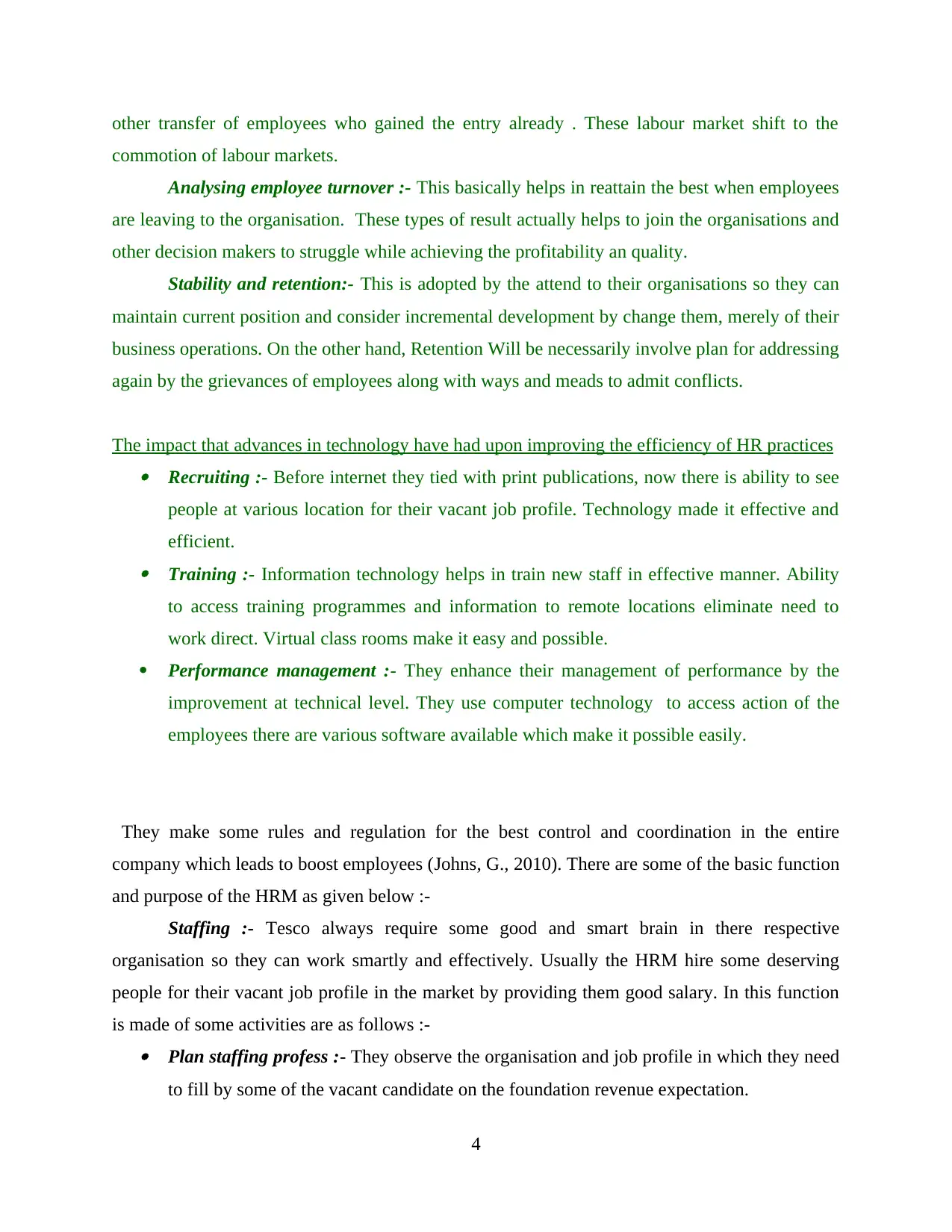
other transfer of employees who gained the entry already . These labour market shift to the
commotion of labour markets.
Analysing employee turnover :- This basically helps in reattain the best when employees
are leaving to the organisation. These types of result actually helps to join the organisations and
other decision makers to struggle while achieving the profitability an quality.
Stability and retention:- This is adopted by the attend to their organisations so they can
maintain current position and consider incremental development by change them, merely of their
business operations. On the other hand, Retention Will be necessarily involve plan for addressing
again by the grievances of employees along with ways and meads to admit conflicts.
The impact that advances in technology have had upon improving the efficiency of HR practices Recruiting :- Before internet they tied with print publications, now there is ability to see
people at various location for their vacant job profile. Technology made it effective and
efficient. Training :- Information technology helps in train new staff in effective manner. Ability
to access training programmes and information to remote locations eliminate need to
work direct. Virtual class rooms make it easy and possible.
Performance management :- They enhance their management of performance by the
improvement at technical level. They use computer technology to access action of the
employees there are various software available which make it possible easily.
They make some rules and regulation for the best control and coordination in the entire
company which leads to boost employees (Johns, G., 2010). There are some of the basic function
and purpose of the HRM as given below :-
Staffing :- Tesco always require some good and smart brain in there respective
organisation so they can work smartly and effectively. Usually the HRM hire some deserving
people for their vacant job profile in the market by providing them good salary. In this function
is made of some activities are as follows :- Plan staffing profess :- They observe the organisation and job profile in which they need
to fill by some of the vacant candidate on the foundation revenue expectation.
4
commotion of labour markets.
Analysing employee turnover :- This basically helps in reattain the best when employees
are leaving to the organisation. These types of result actually helps to join the organisations and
other decision makers to struggle while achieving the profitability an quality.
Stability and retention:- This is adopted by the attend to their organisations so they can
maintain current position and consider incremental development by change them, merely of their
business operations. On the other hand, Retention Will be necessarily involve plan for addressing
again by the grievances of employees along with ways and meads to admit conflicts.
The impact that advances in technology have had upon improving the efficiency of HR practices Recruiting :- Before internet they tied with print publications, now there is ability to see
people at various location for their vacant job profile. Technology made it effective and
efficient. Training :- Information technology helps in train new staff in effective manner. Ability
to access training programmes and information to remote locations eliminate need to
work direct. Virtual class rooms make it easy and possible.
Performance management :- They enhance their management of performance by the
improvement at technical level. They use computer technology to access action of the
employees there are various software available which make it possible easily.
They make some rules and regulation for the best control and coordination in the entire
company which leads to boost employees (Johns, G., 2010). There are some of the basic function
and purpose of the HRM as given below :-
Staffing :- Tesco always require some good and smart brain in there respective
organisation so they can work smartly and effectively. Usually the HRM hire some deserving
people for their vacant job profile in the market by providing them good salary. In this function
is made of some activities are as follows :- Plan staffing profess :- They observe the organisation and job profile in which they need
to fill by some of the vacant candidate on the foundation revenue expectation.
4
Paraphrase This Document
Need a fresh take? Get an instant paraphrase of this document with our AI Paraphraser
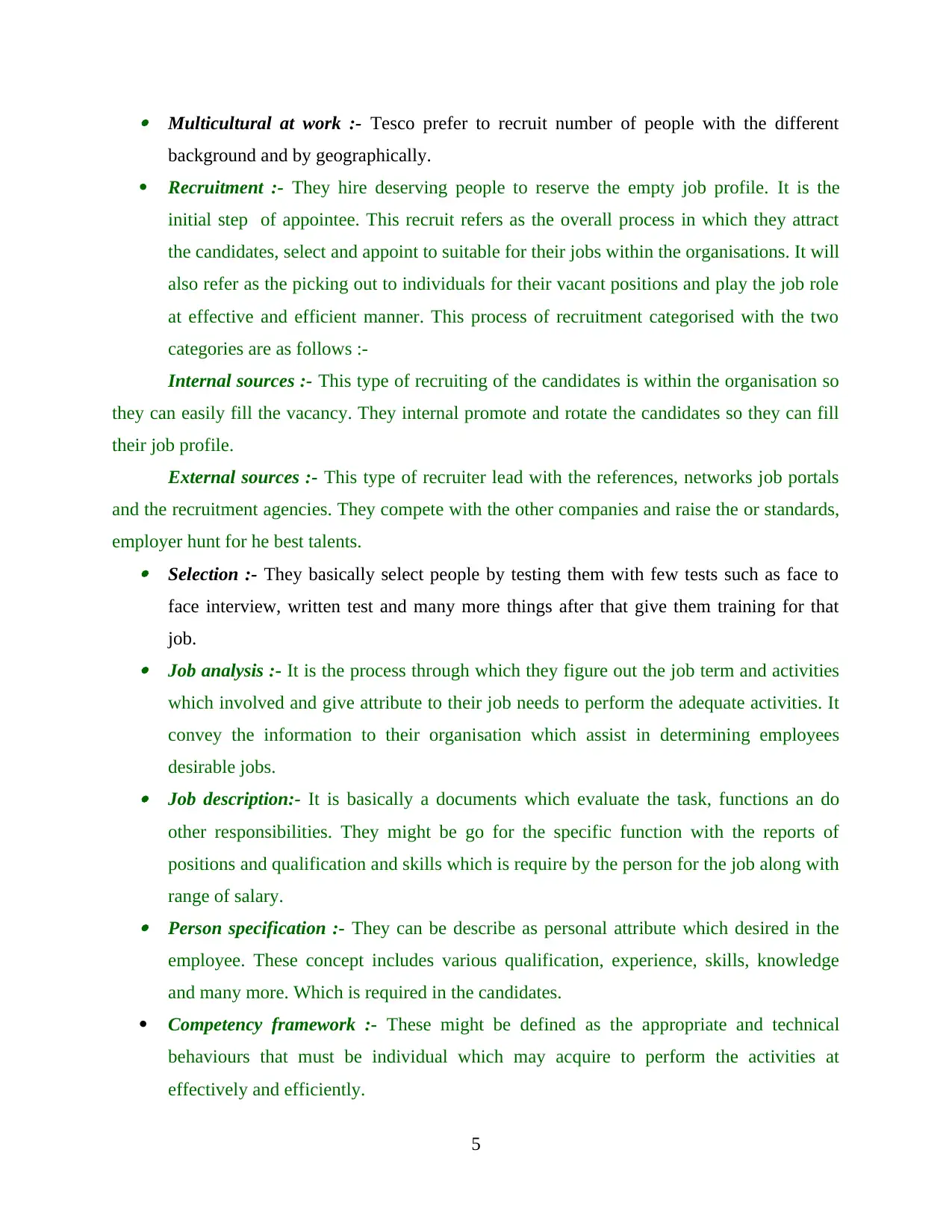
Multicultural at work :- Tesco prefer to recruit number of people with the different
background and by geographically.
Recruitment :- They hire deserving people to reserve the empty job profile. It is the
initial step of appointee. This recruit refers as the overall process in which they attract
the candidates, select and appoint to suitable for their jobs within the organisations. It will
also refer as the picking out to individuals for their vacant positions and play the job role
at effective and efficient manner. This process of recruitment categorised with the two
categories are as follows :-
Internal sources :- This type of recruiting of the candidates is within the organisation so
they can easily fill the vacancy. They internal promote and rotate the candidates so they can fill
their job profile.
External sources :- This type of recruiter lead with the references, networks job portals
and the recruitment agencies. They compete with the other companies and raise the or standards,
employer hunt for he best talents. Selection :- They basically select people by testing them with few tests such as face to
face interview, written test and many more things after that give them training for that
job. Job analysis :- It is the process through which they figure out the job term and activities
which involved and give attribute to their job needs to perform the adequate activities. It
convey the information to their organisation which assist in determining employees
desirable jobs. Job description:- It is basically a documents which evaluate the task, functions an do
other responsibilities. They might be go for the specific function with the reports of
positions and qualification and skills which is require by the person for the job along with
range of salary. Person specification :- They can be describe as personal attribute which desired in the
employee. These concept includes various qualification, experience, skills, knowledge
and many more. Which is required in the candidates.
Competency framework :- These might be defined as the appropriate and technical
behaviours that must be individual which may acquire to perform the activities at
effectively and efficiently.
5
background and by geographically.
Recruitment :- They hire deserving people to reserve the empty job profile. It is the
initial step of appointee. This recruit refers as the overall process in which they attract
the candidates, select and appoint to suitable for their jobs within the organisations. It will
also refer as the picking out to individuals for their vacant positions and play the job role
at effective and efficient manner. This process of recruitment categorised with the two
categories are as follows :-
Internal sources :- This type of recruiting of the candidates is within the organisation so
they can easily fill the vacancy. They internal promote and rotate the candidates so they can fill
their job profile.
External sources :- This type of recruiter lead with the references, networks job portals
and the recruitment agencies. They compete with the other companies and raise the or standards,
employer hunt for he best talents. Selection :- They basically select people by testing them with few tests such as face to
face interview, written test and many more things after that give them training for that
job. Job analysis :- It is the process through which they figure out the job term and activities
which involved and give attribute to their job needs to perform the adequate activities. It
convey the information to their organisation which assist in determining employees
desirable jobs. Job description:- It is basically a documents which evaluate the task, functions an do
other responsibilities. They might be go for the specific function with the reports of
positions and qualification and skills which is require by the person for the job along with
range of salary. Person specification :- They can be describe as personal attribute which desired in the
employee. These concept includes various qualification, experience, skills, knowledge
and many more. Which is required in the candidates.
Competency framework :- These might be defined as the appropriate and technical
behaviours that must be individual which may acquire to perform the activities at
effectively and efficiently.
5

Improve polices :- Human resources department usually make some rules and regulation
so they can maintain the disciplinary environment at work and providing them healthy working
condition (Pfeffer, 2010). Through this they help in to develop the organisation and policies
which actually groom to employees. They also deal with policies like, working hour timings,
dress code, other policies which leads to the discipline in the Tesco.
Benefits administration :- They try not bias with the employees they pay them fairly and
treat them equally. They maintain and stimulate the workers at the work plac sop they can
concerned with the work more,. These things also provide them better opportunities and give
them equal chance to raise their growth. Thy provide them compensation such as bonuses, pay
and other benefits of medical.
Training and development :- It is important part to train the new candidates and the
existing one time to time so through this they will perform better at the work place. Market is
very dynamic and they need to be make them updated and cop up with the external environment.
P 2 Strengths and weaknesses of different approaches to recruitments and selection process
Recruitment is very crucial process in the entire organisation and they have to fill the job
profile with exact deserving candidate who can give their best and perform good at the Tesco
organisation (ulton and et.al., 2011). The selection process go with various steps such as by
written process, interview, group discussion and many more. If they clear them by all then that
candidate can be declare as selected. There are also some positive as well as negative aspects of
these approaches some of them are as follows :-
Strength Weaknesses
Through this process the company get chance
to recruit more talented people so through this
they can lead to the success and growth. These
also contribute in the company Tesco by
providing them good ideas and concept which
can be beneficial for the company and help in
increase the profit.
This process is very time consuming this is the
one of the major weakness of this approach.
Some time following that kind of deserving
people cant help them and not able to find then
this will lead to the time wastage for the
organisation. Instead of this they need to adopt
another methods in which they easily go there
such as public spaces, advertisements, job fairs
and many more places (Zott and Amit, 2010).
6
so they can maintain the disciplinary environment at work and providing them healthy working
condition (Pfeffer, 2010). Through this they help in to develop the organisation and policies
which actually groom to employees. They also deal with policies like, working hour timings,
dress code, other policies which leads to the discipline in the Tesco.
Benefits administration :- They try not bias with the employees they pay them fairly and
treat them equally. They maintain and stimulate the workers at the work plac sop they can
concerned with the work more,. These things also provide them better opportunities and give
them equal chance to raise their growth. Thy provide them compensation such as bonuses, pay
and other benefits of medical.
Training and development :- It is important part to train the new candidates and the
existing one time to time so through this they will perform better at the work place. Market is
very dynamic and they need to be make them updated and cop up with the external environment.
P 2 Strengths and weaknesses of different approaches to recruitments and selection process
Recruitment is very crucial process in the entire organisation and they have to fill the job
profile with exact deserving candidate who can give their best and perform good at the Tesco
organisation (ulton and et.al., 2011). The selection process go with various steps such as by
written process, interview, group discussion and many more. If they clear them by all then that
candidate can be declare as selected. There are also some positive as well as negative aspects of
these approaches some of them are as follows :-
Strength Weaknesses
Through this process the company get chance
to recruit more talented people so through this
they can lead to the success and growth. These
also contribute in the company Tesco by
providing them good ideas and concept which
can be beneficial for the company and help in
increase the profit.
This process is very time consuming this is the
one of the major weakness of this approach.
Some time following that kind of deserving
people cant help them and not able to find then
this will lead to the time wastage for the
organisation. Instead of this they need to adopt
another methods in which they easily go there
such as public spaces, advertisements, job fairs
and many more places (Zott and Amit, 2010).
6
⊘ This is a preview!⊘
Do you want full access?
Subscribe today to unlock all pages.

Trusted by 1+ million students worldwide
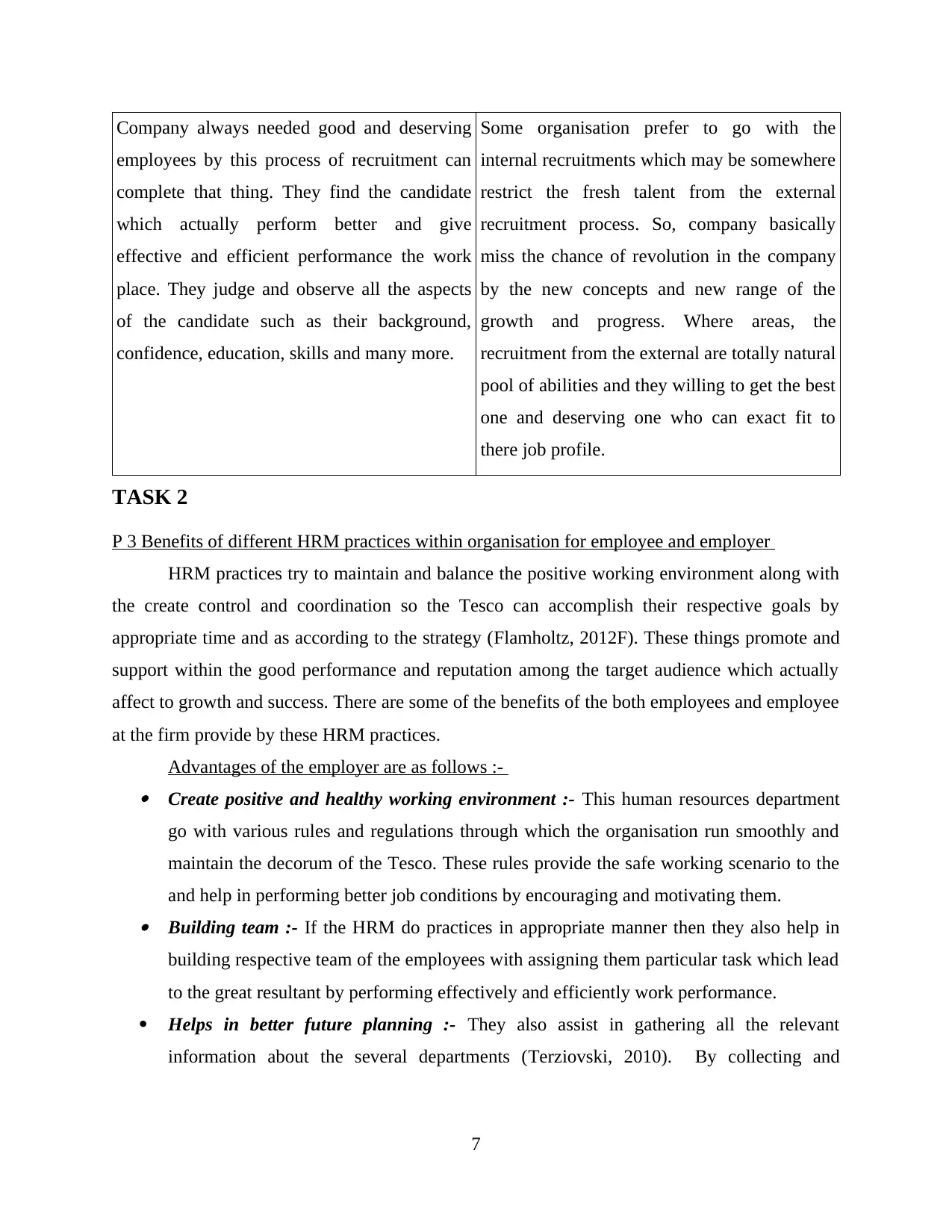
Company always needed good and deserving
employees by this process of recruitment can
complete that thing. They find the candidate
which actually perform better and give
effective and efficient performance the work
place. They judge and observe all the aspects
of the candidate such as their background,
confidence, education, skills and many more.
Some organisation prefer to go with the
internal recruitments which may be somewhere
restrict the fresh talent from the external
recruitment process. So, company basically
miss the chance of revolution in the company
by the new concepts and new range of the
growth and progress. Where areas, the
recruitment from the external are totally natural
pool of abilities and they willing to get the best
one and deserving one who can exact fit to
there job profile.
TASK 2
P 3 Benefits of different HRM practices within organisation for employee and employer
HRM practices try to maintain and balance the positive working environment along with
the create control and coordination so the Tesco can accomplish their respective goals by
appropriate time and as according to the strategy (Flamholtz, 2012F). These things promote and
support within the good performance and reputation among the target audience which actually
affect to growth and success. There are some of the benefits of the both employees and employee
at the firm provide by these HRM practices.
Advantages of the employer are as follows :- Create positive and healthy working environment :- This human resources department
go with various rules and regulations through which the organisation run smoothly and
maintain the decorum of the Tesco. These rules provide the safe working scenario to the
and help in performing better job conditions by encouraging and motivating them. Building team :- If the HRM do practices in appropriate manner then they also help in
building respective team of the employees with assigning them particular task which lead
to the great resultant by performing effectively and efficiently work performance.
Helps in better future planning :- They also assist in gathering all the relevant
information about the several departments (Terziovski, 2010). By collecting and
7
employees by this process of recruitment can
complete that thing. They find the candidate
which actually perform better and give
effective and efficient performance the work
place. They judge and observe all the aspects
of the candidate such as their background,
confidence, education, skills and many more.
Some organisation prefer to go with the
internal recruitments which may be somewhere
restrict the fresh talent from the external
recruitment process. So, company basically
miss the chance of revolution in the company
by the new concepts and new range of the
growth and progress. Where areas, the
recruitment from the external are totally natural
pool of abilities and they willing to get the best
one and deserving one who can exact fit to
there job profile.
TASK 2
P 3 Benefits of different HRM practices within organisation for employee and employer
HRM practices try to maintain and balance the positive working environment along with
the create control and coordination so the Tesco can accomplish their respective goals by
appropriate time and as according to the strategy (Flamholtz, 2012F). These things promote and
support within the good performance and reputation among the target audience which actually
affect to growth and success. There are some of the benefits of the both employees and employee
at the firm provide by these HRM practices.
Advantages of the employer are as follows :- Create positive and healthy working environment :- This human resources department
go with various rules and regulations through which the organisation run smoothly and
maintain the decorum of the Tesco. These rules provide the safe working scenario to the
and help in performing better job conditions by encouraging and motivating them. Building team :- If the HRM do practices in appropriate manner then they also help in
building respective team of the employees with assigning them particular task which lead
to the great resultant by performing effectively and efficiently work performance.
Helps in better future planning :- They also assist in gathering all the relevant
information about the several departments (Terziovski, 2010). By collecting and
7
Paraphrase This Document
Need a fresh take? Get an instant paraphrase of this document with our AI Paraphraser
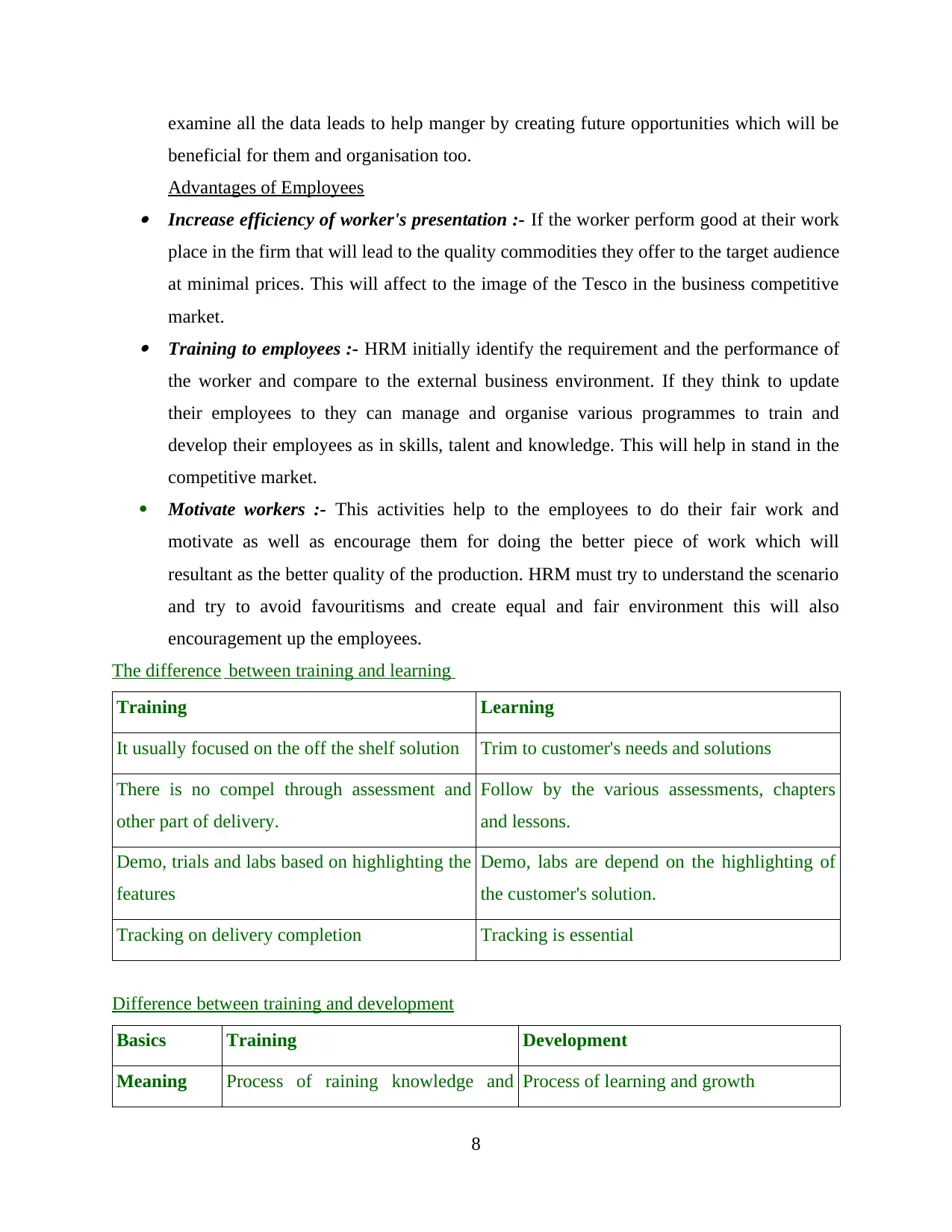
examine all the data leads to help manger by creating future opportunities which will be
beneficial for them and organisation too.
Advantages of Employees Increase efficiency of worker's presentation :- If the worker perform good at their work
place in the firm that will lead to the quality commodities they offer to the target audience
at minimal prices. This will affect to the image of the Tesco in the business competitive
market. Training to employees :- HRM initially identify the requirement and the performance of
the worker and compare to the external business environment. If they think to update
their employees to they can manage and organise various programmes to train and
develop their employees as in skills, talent and knowledge. This will help in stand in the
competitive market.
Motivate workers :- This activities help to the employees to do their fair work and
motivate as well as encourage them for doing the better piece of work which will
resultant as the better quality of the production. HRM must try to understand the scenario
and try to avoid favouritisms and create equal and fair environment this will also
encouragement up the employees.
The difference between training and learning
Training Learning
It usually focused on the off the shelf solution Trim to customer's needs and solutions
There is no compel through assessment and
other part of delivery.
Follow by the various assessments, chapters
and lessons.
Demo, trials and labs based on highlighting the
features
Demo, labs are depend on the highlighting of
the customer's solution.
Tracking on delivery completion Tracking is essential
Difference between training and development
Basics Training Development
Meaning Process of raining knowledge and Process of learning and growth
8
beneficial for them and organisation too.
Advantages of Employees Increase efficiency of worker's presentation :- If the worker perform good at their work
place in the firm that will lead to the quality commodities they offer to the target audience
at minimal prices. This will affect to the image of the Tesco in the business competitive
market. Training to employees :- HRM initially identify the requirement and the performance of
the worker and compare to the external business environment. If they think to update
their employees to they can manage and organise various programmes to train and
develop their employees as in skills, talent and knowledge. This will help in stand in the
competitive market.
Motivate workers :- This activities help to the employees to do their fair work and
motivate as well as encourage them for doing the better piece of work which will
resultant as the better quality of the production. HRM must try to understand the scenario
and try to avoid favouritisms and create equal and fair environment this will also
encouragement up the employees.
The difference between training and learning
Training Learning
It usually focused on the off the shelf solution Trim to customer's needs and solutions
There is no compel through assessment and
other part of delivery.
Follow by the various assessments, chapters
and lessons.
Demo, trials and labs based on highlighting the
features
Demo, labs are depend on the highlighting of
the customer's solution.
Tracking on delivery completion Tracking is essential
Difference between training and development
Basics Training Development
Meaning Process of raining knowledge and Process of learning and growth
8
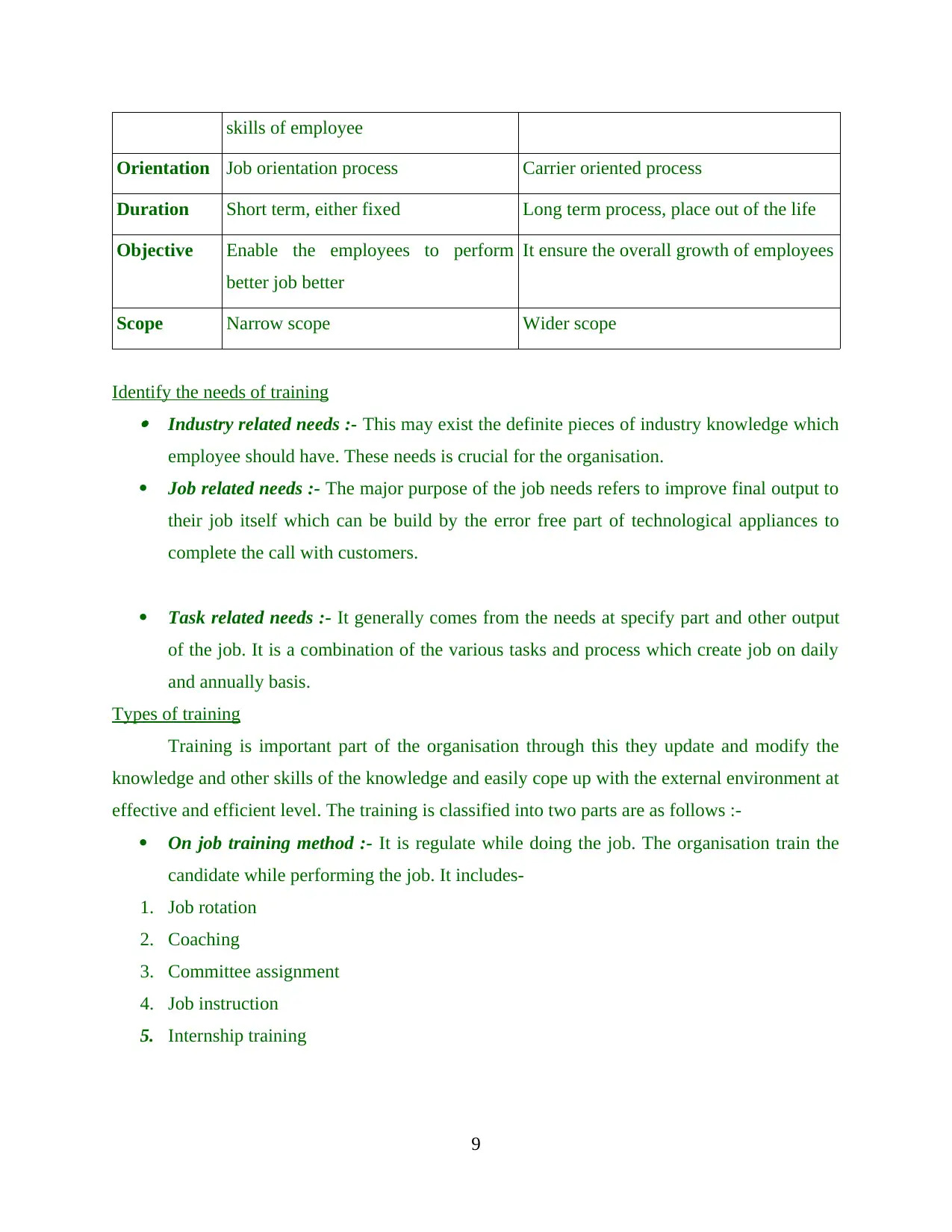
skills of employee
Orientation Job orientation process Carrier oriented process
Duration Short term, either fixed Long term process, place out of the life
Objective Enable the employees to perform
better job better
It ensure the overall growth of employees
Scope Narrow scope Wider scope
Identify the needs of training Industry related needs :- This may exist the definite pieces of industry knowledge which
employee should have. These needs is crucial for the organisation.
Job related needs :- The major purpose of the job needs refers to improve final output to
their job itself which can be build by the error free part of technological appliances to
complete the call with customers.
Task related needs :- It generally comes from the needs at specify part and other output
of the job. It is a combination of the various tasks and process which create job on daily
and annually basis.
Types of training
Training is important part of the organisation through this they update and modify the
knowledge and other skills of the knowledge and easily cope up with the external environment at
effective and efficient level. The training is classified into two parts are as follows :-
On job training method :- It is regulate while doing the job. The organisation train the
candidate while performing the job. It includes-
1. Job rotation
2. Coaching
3. Committee assignment
4. Job instruction
5. Internship training
9
Orientation Job orientation process Carrier oriented process
Duration Short term, either fixed Long term process, place out of the life
Objective Enable the employees to perform
better job better
It ensure the overall growth of employees
Scope Narrow scope Wider scope
Identify the needs of training Industry related needs :- This may exist the definite pieces of industry knowledge which
employee should have. These needs is crucial for the organisation.
Job related needs :- The major purpose of the job needs refers to improve final output to
their job itself which can be build by the error free part of technological appliances to
complete the call with customers.
Task related needs :- It generally comes from the needs at specify part and other output
of the job. It is a combination of the various tasks and process which create job on daily
and annually basis.
Types of training
Training is important part of the organisation through this they update and modify the
knowledge and other skills of the knowledge and easily cope up with the external environment at
effective and efficient level. The training is classified into two parts are as follows :-
On job training method :- It is regulate while doing the job. The organisation train the
candidate while performing the job. It includes-
1. Job rotation
2. Coaching
3. Committee assignment
4. Job instruction
5. Internship training
9
⊘ This is a preview!⊘
Do you want full access?
Subscribe today to unlock all pages.

Trusted by 1+ million students worldwide
1 out of 21
Related Documents
Your All-in-One AI-Powered Toolkit for Academic Success.
+13062052269
info@desklib.com
Available 24*7 on WhatsApp / Email
![[object Object]](/_next/static/media/star-bottom.7253800d.svg)
Unlock your academic potential
Copyright © 2020–2025 A2Z Services. All Rights Reserved. Developed and managed by ZUCOL.





